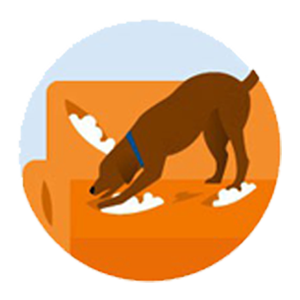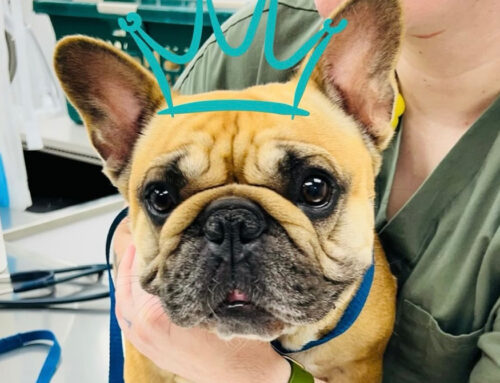No one likes coming home to find a mess – whether that’s an object torn to shreds, furniture damaged, or pee or poop to clean up. But chances are, your dog (or, very rarely, cat) isn’t actually out to get you. He or she is more likely to be scared or nervous, and the mess is the symptom of that anxiety.
It’s normal for pets to be unhappy when their owners leave. But most pets can settle down to nap while their owners are away.
So what is separation anxiety? Separation anxiety is a medical condition where your dog experiences distress when left alone. These pets may cause harm to themselves or their environment in their need to escape or their drive to comfort themselves.
Does Your Dog….


Have Indoor
Accidents


Behave Destructively


Persistently Bark


Attempt to Escape


Pace Incessantly
If so, your pet may be suffering from separation anxiety….
Signs of separation anxiety include:
- House Soiling – urine and/or stool
- Vocalizing – constant barking or whining
- Panting excessively
- Pacing and being unable to settle down
- Destructive behavior – chewing up objects, furniture, parts of the home
- Trying to escape
What triggers separation anxiety?
Any change in routine can trigger anxious behavior. This can include absence of a family member, like a new work or school schedule or a trip. The absence doesn’t have to be long, and some pets will start to show anxious behaviors before the person even leaves. Moving is another stressful event that can trigger anxious behavior. Puppies can show anxiety when separated from their littermates, and senior dogs can develop anxiety in their old age.
How do you treat separation anxiety?
The first thing to do is consult your veterinarian. Your pet may have a medical condition that is causing the behavior change, and treating the problem may fix the behavior. Some examples include pets who are uncomfortable from arthritis, drinking, urinating, and panting more than usual because of Cushing’s disease, or are hyperactive or aggressive from an overactive thyroid (cats).
Once medical issues are ruled out, training starts. Many pets will also benefit from calming supplements and/or medications to allow their anxiety to subside enough that learning can occur.
The first step in training is to provide your pet with proper exercise. A bored pet is more likely to get into trouble. A tired pet is more likely to rest until you come home. Make sure to stimulate your pet’s mind as well as body with new games and activities.

Now, start training your pet to “settle”. This is a command that you train, just like “sit” or “stay”. It means your pet goes to a designated spot like a bed or a crate and relaxes in place. At first, your pet will settle for a very short time. Gradually increase the length of time and the distance you move away before releasing your pet from the command. Use treats and positive reinforcement to keep teaching this command stress-free. Be patient! Once you can leave the room for a short time and return without your pet moving from their settle, you are ready to leave the house for a short time. When you come home, great your pet with the release word and a calm demeanor.

Severely affected pets need additional help beyond training.
Solliquin or Zylkene are calming supplements that decrease the fight-or-flight response and allow learning to occur. Some pets will also respond well to hemp-based supplements – but be careful to avoid any THC, which is extremely toxic to dogs and cats.
Antidepressants like fluoxetine or clomipramine are also very helpful to get the process started for some pets. Start with an appointment with your veterinarian to get your pet the help they need.








Leave A Comment